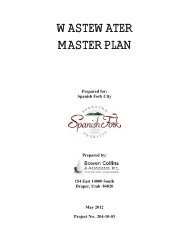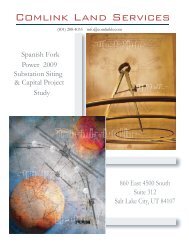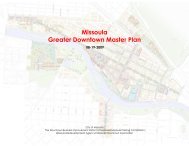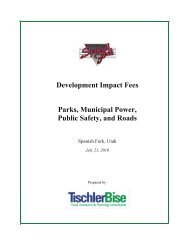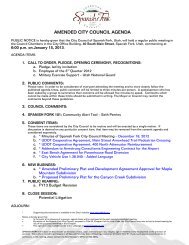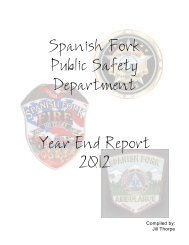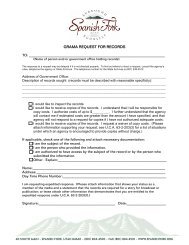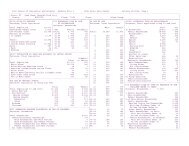Culinary Water System Presentation City Council ... - Spanish Fork
Culinary Water System Presentation City Council ... - Spanish Fork
Culinary Water System Presentation City Council ... - Spanish Fork
You also want an ePaper? Increase the reach of your titles
YUMPU automatically turns print PDFs into web optimized ePapers that Google loves.
<strong>Spanish</strong> <strong>Fork</strong> <strong>City</strong><br />
Public Works<br />
<strong>Culinary</strong> <strong>Water</strong> <strong>System</strong><br />
<strong>Presentation</strong><br />
<strong>City</strong> <strong>Council</strong> Meeting<br />
February 15, 2005
<strong>Spanish</strong> <strong>Fork</strong> <strong>City</strong><br />
Public Works<br />
<strong>Water</strong> <strong>System</strong> History<br />
‣ 1 st Public <strong>System</strong> – Developed around the<br />
turn of the century<br />
‣ Malcolm Springs - Developed about 1903<br />
‣ Cold Springs - Developed about 1953<br />
‣ Crab Creek Springs- Developed 1994<br />
‣ Pipe Network – Distributes water from the<br />
springs to users
<strong>Spanish</strong> <strong>Fork</strong> <strong>City</strong><br />
Public Works<br />
‣ Where does the water come from?<br />
‣ Crab Creek Springs – 43%<br />
‣ Cold Springs – 19%<br />
‣ Malcolm Springs – 38%<br />
‣ Cemetery #1 Well<br />
‣ Ed Clark Well
<strong>Spanish</strong> <strong>Fork</strong> <strong>City</strong><br />
Public Works<br />
Malcolm Springs<br />
Redeveloped 1992
<strong>Spanish</strong> <strong>Fork</strong> <strong>City</strong><br />
Public Works<br />
Malcolm Springs Pumphouse<br />
Constructed 1992
<strong>Spanish</strong> <strong>Fork</strong> <strong>City</strong><br />
Public Works<br />
Cold Springs Pumphouse<br />
Constructed 1992
<strong>Spanish</strong> <strong>Fork</strong> <strong>City</strong><br />
Public Works<br />
Cold Springs Pumphouse<br />
Constructed 1992
<strong>Spanish</strong> <strong>Fork</strong> <strong>City</strong><br />
Public Works<br />
Cold Springs Pumphouse<br />
Constructed 1992
<strong>Spanish</strong> <strong>Fork</strong> <strong>City</strong><br />
Public Works<br />
Upper Crab Creek Springs<br />
Developed 1994
<strong>Spanish</strong> <strong>Fork</strong> <strong>City</strong><br />
Public Works<br />
Upper Crab Creek Springs<br />
Lower Crab Creek Springs
<strong>Spanish</strong> <strong>Fork</strong> <strong>City</strong><br />
Public Works<br />
Crab Creek Pipeline<br />
Constructed 1998
<strong>Spanish</strong> <strong>Fork</strong> <strong>City</strong><br />
Public Works<br />
Crab Creek Pipeline<br />
Constructed 1998
<strong>Spanish</strong> <strong>Fork</strong> <strong>City</strong><br />
Public Works<br />
Crab Creek Pipeline<br />
Constructed 1998
<strong>Spanish</strong> <strong>Fork</strong> <strong>City</strong><br />
Public Works<br />
Public Works<br />
3 Million Gallon Reservoir – Upper
<strong>Spanish</strong> <strong>Fork</strong> <strong>City</strong><br />
Public Works<br />
Inside the 2 Million Gallon Reservoir - Lower
<strong>Spanish</strong> <strong>Fork</strong> <strong>City</strong><br />
Public Works<br />
‣ How much water do we use each year?<br />
• 1,161,472,000 Gallons culinary water in 2004<br />
• Averages over 2200 gallons per minute for<br />
every minute of the year!<br />
• About 80% of culinary water is used in homes<br />
• 125,564 gallons per home (average)
‣ How is the water<br />
treated?<br />
<strong>Spanish</strong> <strong>Fork</strong> <strong>City</strong><br />
• <strong>Spanish</strong> <strong>Fork</strong> <strong>City</strong><br />
uses gaseous chlorine<br />
to disinfect the<br />
drinking water<br />
• The spring water is<br />
chlorinated, the well<br />
water is not<br />
Public Works
‣ <strong>Water</strong> Testing<br />
• Testing at the Sources<br />
• Nitrates<br />
• VOC’s<br />
• Pesticides<br />
• Radionuclides<br />
<strong>Spanish</strong> <strong>Fork</strong> <strong>City</strong><br />
Public Works
‣ <strong>Water</strong> Testing<br />
• Testing in the <strong>System</strong><br />
<strong>Spanish</strong> <strong>Fork</strong> <strong>City</strong><br />
Public Works<br />
• Bacteria Testing (Monthly)<br />
• Lead & Copper (30 every 3 years)<br />
• Disinfection by-products (Quarterly)
<strong>Spanish</strong> <strong>Fork</strong> <strong>City</strong><br />
Public Works<br />
‣ Do we add Fluoride to the <strong>Water</strong>?<br />
• NO!<br />
• There is fluoride that occurs naturally in the<br />
water from about .2 to .4 mg/L<br />
• Areas that add fluoride to the drinking water<br />
range from .7 to 1.4 mg/L
<strong>Spanish</strong> <strong>Fork</strong> <strong>City</strong><br />
Public Works<br />
‣ How hard is the water in <strong>Spanish</strong> <strong>Fork</strong><br />
<strong>City</strong>?<br />
• Our water has a hardness of 17-21 grains or<br />
362 mg per liter
<strong>Spanish</strong> <strong>Fork</strong> <strong>City</strong><br />
Public Works<br />
‣ How much water pressure is available to<br />
the homes?<br />
• <strong>Spanish</strong> <strong>Fork</strong> <strong>City</strong> typically provides between<br />
45 and 100 psi in the culinary water system<br />
• If you live at the upper end of the pressure<br />
zone you will be closer to 45 psi<br />
• If you live at the lower end of the pressure<br />
zone you will be closer to 100 psi
Pressure Zones<br />
<strong>Spanish</strong> <strong>Fork</strong> <strong>City</strong><br />
Public Works
<strong>Spanish</strong> <strong>Fork</strong> <strong>City</strong><br />
Public Works<br />
‣ What if you have low water pressure?<br />
• Check with your neighbors<br />
• Is it a neighborhood problem or is it in your home<br />
• If it appears to affect other homes, contact the city<br />
at 798-5000 during business hours or at 798-5039<br />
after hours<br />
• Check your pressure regulator
<strong>Spanish</strong> <strong>Fork</strong> <strong>City</strong><br />
Public Works<br />
www.spanishfork.org
<strong>Spanish</strong> <strong>Fork</strong> <strong>City</strong><br />
Public Works<br />
‣ <strong>Water</strong> Line Replacement<br />
• Reasons for Replacement<br />
• Old Lines – Installed in the<br />
1930’s s and 1940’s<br />
• Corrosion of existing pipes<br />
• Undersized Lines<br />
• Many 4” 4 and 6” 6 Lines<br />
• Minimum size 8” 8<br />
• Fire Flows
<strong>Spanish</strong> <strong>Fork</strong> <strong>City</strong><br />
Public Works
<strong>Spanish</strong> <strong>Fork</strong> <strong>City</strong><br />
Public Works
‣ <strong>Water</strong> Line Replacement<br />
<strong>Spanish</strong> <strong>Fork</strong> <strong>City</strong><br />
Public Works<br />
• <strong>Water</strong> lines replaced to date<br />
• 66 blocks<br />
• 277 blocks that need replacement<br />
• Plan about 12 blocks per year<br />
• 20 to 25 years to complete
<strong>Spanish</strong> <strong>Fork</strong> <strong>City</strong><br />
Public Works<br />
Questions?



